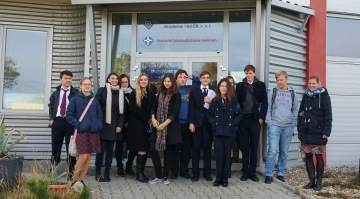What doesn’t kill you makes you more knowledgeable

From the courageous students of Sekunda to the experienced students of Oktava, we headed to the open day at the Institute of Experimental Medicine AS CR. Many thanks to Mr. Červený and his ice breaker which informed us about nuclear magnetic resonance.
Afterwards, a busy schedule of lectures awaited us. Thankfully, our teachers (Mrs. Kožnarová and Mrs. Hladíková) saved us from making tough choices and decided on our behalves that the first lecture we would attend would be “Stem Cells and Their Therapeutic Potential.” Whereas the Septima and Oktava students revised their knowledge of the IB Biology syllabus, we younger students faced loads of new information about the haematopoietic and mesenchymal stem cells and their differentiation, as well as differences between totipotent, pluripotent and multipotent cells. The presentation also included information about the usage of stem cells in the treatment of damaged surface of the eye. Those of you who are not enthralled by the idea of cornea transplantation can hope that, in the future, this type of stem cell therapy will succeed. It will take a while before this innovative method is introduced to the public; however, the lecture inspired a lot of us to someday soon to apply our current gluing-school- paper-skills for the more fascinating gluing prospect of cell manipulation using a special fibrin glue instead.
The next lecture detailed the workings of glial cells. The younger students were introduced to this whole new concept and, although our older students at least knew what was going on, even they were surprised by the extensive knowledge of the lecturer. As a whole, astrocytes, oligodendrocytes and Schwann cells were not entirely unknown to those of us who have looked at the installation of the central nervous system in our biology classes. For those who haven’t, these are cells which provide support for neurons, and their functions vary from energetic substrates to the regulation of pH and homeostasis of the central nervous system. A significant amount of time was devoted to the importance of glial cells in regards to the maintenance of glutamate concentration in the extracellular space of neurons and diseases, which are believed to be linked to the malfunction of transporters of glutamate such as ALS or Alzheimer’s diseases. There is positive news for all consumers of packaged Asian noodle soups – if you are an adult, you do not need to be too concerned as your brain is likely able to deal with the high content of glutamate found in these products; however, take caution with the products with younger children for whom excessive amounts of glutamate can be dangerous.
The third lecture was about tissue engineering and was largely characterized by our incapability to comprehend some of the Slovak phrases (along with our mental exhaustion) which caused our attention spans to decline. Firstly, we had a chance to revise the essentials about stem cells, further extended by the examples of their use in the therapy of various diseases. We will certainly fully appreciate all of these possibilities of regenerative medicine when we suffer from arthrosis in a few decades and, once again, these stem cells are our big hope.
So, what have we learned? Along with lots of new information about the current biomedical research field, we have gained motivation for further intensive study, which was a positive conclusion for our pedagogical supervisors; we survived with no significant mental or physical harm, and we already look forward to future events.
Michaela Mrázková